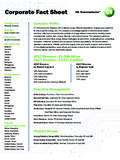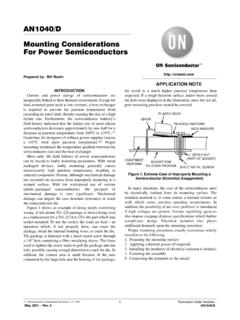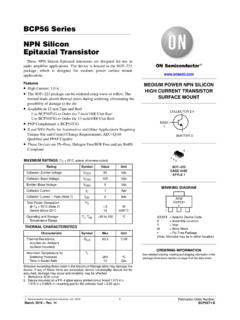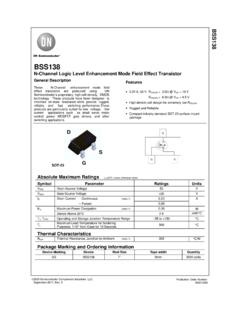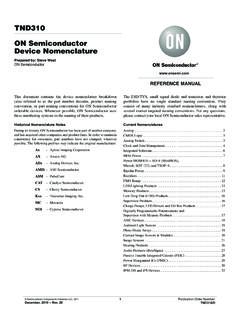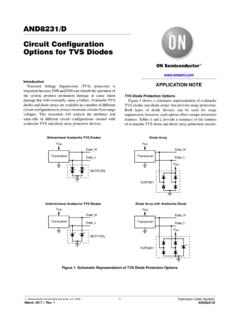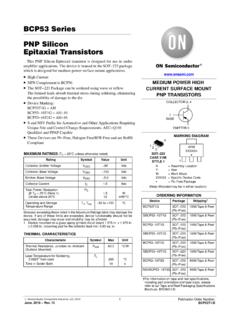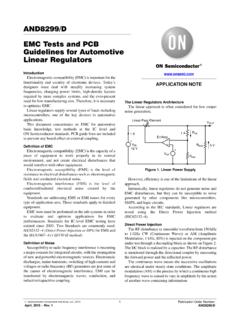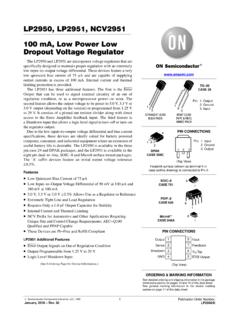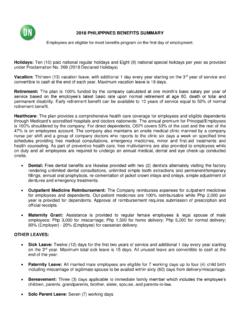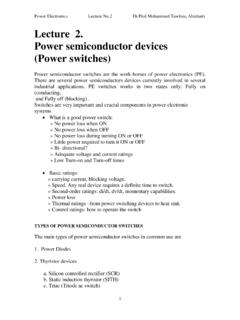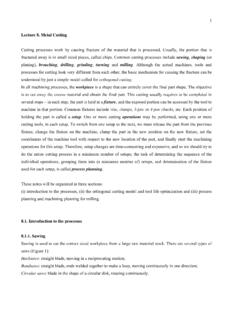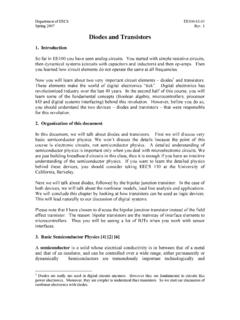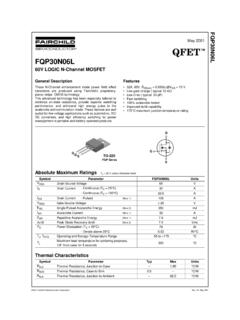Transcription of MOC3052M - ON Semiconductor
1 DATA Semiconductor Components Industries, LLC, 2016 September, 2022 Rev. 41 Publication Order Number: MOC3052M /D6-Pin DIP Random-PhaseTriac Driver Optocoupler(600 Volt Peak)MOC3051M, MOC3052M ,MOC3053 MThe MOC3051M, MOC3052M and MOC3053M consist of a GaAsinfrared emitting diode optically coupled to a non zero crossingsilicon bilateral AC switch (triac). These devices isolate low voltagelogic from 115 VAC and 240 VAC lines to provide random phasecontrol of high current triacs or thyristors. These devices featuregreatly enhanced static dv/dt capability to ensure stable switchingperformance of inductive Excellent IFT Stability IR Emitting Diode Has Low Degradation 600 V Peak Blocking Voltage Safety and Regulatory Approvals UL1577, 4,170 VACRMS for 1 Minute DIN EN/IEC60747 5 5 Typical Applications Solenoid/Valve Controls Lamp Ballasts Static AC Power Switch Interfacing Microprocessors to 115 VAC and 240 VAC Peripherals Solid State Relay Incandescent Lamp Dimmers Temperature Controls Motor ControlsPDIP6 CASE 646 BYPDIP6 CASE 646 BZPDIP6 CASE 646 BXSee detailed ordering, marking and shipping information onpage 9 of this data INFORMATIONMARKING DIAGRAMON= ON Semiconductor LogoMOC3051= Device CodeV= DIN EN/IEC60747 5 5 OptionX= One Digit Year CodeYY= Two Digit Work Week, Q= Assembly Package CodeMOC3051V X YY QPIN CONNECTIONSMOC3051M, MOC3052M , AND INSULATIONS RATINGSAs per DIN EN/IEC 60747 5 5.
2 This optocoupler is suitable for safe electrical insulation only within the safety limit data. Compliance withthe safety ratings shall be ensured by means of protective Classifications per DIN VDE 0110 Table 1, For Rated Mains Voltage< 150 VRMSI IV< 300 VRMSI IVClimatic Classification40/85/21 Pollution Degree (DIN VDE 0110 )2 Comparative Tracking Index175 SymbolParameterValueUnitVPRI nput to Output Test Voltage, Method A, VIORM x = VPR, Type andSample Test with tm = 10 s, Partial Discharge < 5 pC1360 VpeakInput to Output Test Voltage, Method B, VIORM x = VPR, 100% Production Test with tm = 1 s, Partial Discharge < 5 pC1594 VpeakVIORMM aximum Working Insulation Voltage850 VpeakVIOTMH ighest Allowable Over Voltage6000 VpeakExternal Creepage 7mmExternal Clearance 7mmExternal Clearance (for Option TV, Lead Spacing) 10mmDTID istance Through Insulation (Insulation Thickness) Resistance at TS, VIO = 500 V> 109 WMOC3051M, MOC3052M , RATINGS TA = 25 C unless otherwise DEVICETSTGS torage Temperature 40 to +125 CTOPRO perating Temperature 40 to +85 CTJJ unction Temperature Range 40 to +100 CTSOLLead Solder Temperature260 for 10 seconds CPDT otal Device Power Dissipation at 25 C Ambient330mWDerate Above 25 CEMITTERIFC ontinuous Forward Current60mAVRR everse Voltage3 VPDT otal Power Dissipation at 25 C Ambient100mWDerate Above 25 CDETECTORVDRMOff State Output Terminal Voltage600 VITSMPeak Non Repetitive Surge Current (Single Cycle 60 Hz Sine Wave)1 APDT otal Power Dissipation at 25 C Ambient300mWDerate Above 25 C4mW/ CStresses exceeding those listed in the Maximum Ratings table may damage the device.
3 If any of these limits are exceeded, device functionalityshould not be assumed, damage may occur and reliability may be CHARACTERISTICS (TA = 25 C unless otherwise specified)INDIVIDUAL COMPONENT CHARACTERISTICSS ymbolParametersCharacteristicMinTypMaxUn itEMITTERVFI nput Forward VoltageIF = 10 Leakage CurrentVR = 3 Blocking Current, Either DirectionVDRM = 600 V, IF = 0(Note 1)10100nAVTMPeak On State Voltage, Either DirectionITM = 100 mA peak, IF = Rate of Rise of Off State VoltageIF = 0, VDRM = 600 V1000V/msTRANSFER CHARACTERISTICSS ymbolDC CharacteristicTest ConditionsDeviceMinTypMaxUnitIFTLED Trigger Current,Either DirectionMain Terminal Voltage = 3 V (Note 2)MOC3051M15mAMOC3052M10 MOC3053M6 IHHolding Current, Either DirectionAll540mAMOC3051M, MOC3052M , CHARACTERISTICS (TA = 25 C unless otherwise specified) (continued)INDIVIDUAL COMPONENT CHARACTERISTICSS ymbolCharacteristicTest ConditionsMinTypMaxUnitISOLATION CHARACTERISTICSVISOI nput Output Isolation Voltage (Note 3)f = 60 Hz, t = 1 Minute4170 VACRMSRISOI solation ResistanceVI O = 500 VDC1011 WCISOI solation CapacitanceV = 0 V, f = 1 Test voltage must be applied within dv/dt All devices will trigger at an IF value greater than or equal to the maximum IFT specification.
4 For optimum operation over temperature andlifetime of the device, the LED should be biased with an IF that is at least 50% higher than the maximum IFT specification. The IF should notexceed the absolute maximum rating of 60 : For MOC3052M , the minimum IF bias should be 10 mA x 150% = 15 Isolation voltage, VISO, is an internal device dielectric breakdown rating. For this test, pins 1 and 2 are common, and pins 4, 5 and 6 , MOC3052M , CHARACTERISTICSIF LED FORWARD CURRENT (mA)VF FORWARD VOLTAGE (V)Figure 1. LED Forward Voltage vs. Forward CurrentFigure 2. On State CharacteristicsVTM ON STATE VOLTAGE (V)ITM ON STATE CURRENT (mA)TA AMBIENT TEMPERATURE ( C)IFT (NORMALIZED) = IFT (TA) / IFT (TA = 25 C)Figure 3. LED Trigger Current vs. AmbientTemperatureFigure 4. LED Trigger Current vs. LED Pulse WidthIFT (NORMALIZED) = IFT (PW) / IFT (PW = 100 ms)PW LED TRIGGER PULSE WIDTH (ms)TA, AMBIENT TEMPERATURE ( C)IH (NORMALIZED) = IH (TA) / IH (TA = 25 C)Figure 5. Holding Current vs.
5 AmbientTemperatureFigure 6. Leakage Current vs. AmbientTemperatureIDRM LEAKAGE CURRENT (nA)TA, AMBIENT TEMPERATURE ( C) 400 300 200 TO PW = 100 s110100 3 2 2 101 23 40 20020406080100110100 40 20020406080100 40 20020406080100TA = 40 CTA = 25 CTA = 85 CNORMALIZED TO TA = 25 CNORMALIZED TO TA = 25 CVDRM = 600 VMOC3051M, MOC3052M , INFORMATIONB asic Triac Driver CircuitThe random phase triac drivers MOC3051M, MOC3052M and MOC3053M can allow snubberlessoperations in applications where load is resistive and theexternal generated noise in the AC line is below itsguaranteed dv/dt withstand capability. For theseapplications, a snubber circuit is not necessary when a noiseinsensitive power triac is used. Figure 7 shows the circuitdiagram. The triac driver is directly connected to the triacmain terminal 2 and a series resistor R which limits thecurrent to the triac driver. Current limiting resistor R musthave a minimum value which restricts the current into thedriver to maximum 1 power dissipation of this current limiting resistor andthe triac driver is very small because the power triac carriesthe load current as soon as the current through driver andcurrent limiting resistor reaches the trigger current of thepower triac.
6 The switching transition times for the driver isonly one micro second and for power triacs typical fourmicro Driver Circuit for Noisy EnvironmentsWhen the transient rate of rise and amplitude are expectedto exceed the power triacs and triac drivers maximumratings a snubber circuit as shown in Figure 8 isrecommended. Fast transients are slowed by the R Csnubber and excessive amplitudes are clipped by the MetalOxide Varistor Driver Circuit for Extremely Noisy EnvironmentsAs specified in the noise standards IEEE472 andIEC255 control applications do specify a maximumtransient noise dv/dt and peak voltage which issuper imposed onto the AC line voltage. In order to pass thisenvironment noise test a modified snubber network asshown in Figure 9 is Trigger Current versus TemperatureRecommended operating LED control current IF liesbetween the guaranteed IFT and absolute maximum 3 shows the increase of the trigger current when thedevice is expected to operate at an ambient temperaturebelow 25 C.
7 Multiply the datasheet guaranteed IFT with thenormalized IFT shown on this graph and an allowance forLED degradation over :IFT = 10 mA, LED degradation factor = 20%IF at 40 C = 10 mA 120% = 15 mALED Trigger Current vs. Pulse WidthRandom phase triac drivers are designed to be phasecontrollable. They may be triggered at any phase anglewithin the AC sine wave. Phase control may beaccomplished by an AC line zero cross detector and avariable pulse delay generator which is synchronized to thezero cross detector. The same task can be accomplished bya microprocessor which is synchronized to the AC zerocrossing. The phase controlled trigger current may be a veryshort pulse which saves energy delivered to the input trigger pulse currents shorter than 100 ms must haveincreased amplitude as shown on Figure 4. This graph showsthe dependency of the trigger current IFT versus the pulsewidth. IFT in this graph is normalized in respect to theminimum specified IFT for static condition, which isspecified in the device characteristic.
8 The normalized IFThas to be multiplied with the devices guaranteed statictrigger :IFT = 10 mA, Trigger PW = 4 msIF (pulsed) = 10 mA 3 = 30 mAMinimum LED Off Time in Phase Control ApplicationsIn phase control applications, one intends to be able tocontrol each AC sine half wave from 0 to 180 . Turn on at0 means full power and turn on at 180 means zero is not quite possible in reality because triac driver andtriac have a fixed turn on time when activated at zerodegrees. At a phase control angle close to 180 the driver sturn on pulse at the trailing edge of the AC sine wave mustbe limited to end 200 ms before AC zero cross as shown inFigure 10. This assures that the triac driver has time to switchoff. Shorter times may cause loss of control at the followinghalf dv/dtCritical rate of rise of off state voltage or static dv/dt is atriac characteristic that rates its ability to prevent falsetriggering in the event of fast rising line voltage transientswhen it is in the off state.
9 When driving a discrete powertriac, the triac driver optocoupler switches back to off stateonce the power triac is triggered. However, during thecommutation of the power triac in application where theload is inductive, both triacs are subjected to fast risingvoltages. The static dv/dt rating of the triac driveroptocoupler and the commutating dv/dt rating of the powertriac must be taken into consideration in snubber circuitdesign to prevent false triggering and commutation , MOC3052M , 7. Basic Driver CircuitLOADRTRIAC DRIVERCONTROLAC LINEQPOWER = (VCC VFLED VSATQ) / IFTR = VPAC / ITSMF igure 8. Triac Driver Circuit for Noisy EnvironmentsLOADRTRIAC DRIVERCONTROLAC LINEPOWER Snubber values RS = 33 W, CS = mFMOV ( metal oxide Varistor) protects power triac anddriver from transient overvoltages > VDRM maxFigure 9. Triac Driver Circuit for Extremely Noisy EnvironmentsLOADRTRIAC DRIVERCONTROLAC LINEPOWER snubber to pass IEEE472 and IEC255 4 noise testsRS = 47 W, CS = mFFigure 10.
10 Minimum Time for LED Turn Off to Zero Crossing0 180 LED PWLED CurrentLED turn off min. 200 msAC LineMOC3051M, MOC3052M , PROFILEF igure 11. Reflow ProfileProfile FeaturePb Free Assembly ProfileTemperature Minimum (Tsmin)150 CTemperature Maximum (Tsmax)200 CTime (tS) from (Tsmin to Tsmax)60 seconds to 120 secondsRamp up Rate (TL to TP)3 C/second maximumLiquidous Temperature (TL)217 CTime (tL) Maintained Above (TL)60 seconds to 150 secondsPeak Body Package Temperature260 C +0 C / 5 CTime (tP) within 5 C of 260 C30 secondsRamp down Rate (TP to TL)6 C/second maximumTime 25 C to Peak Temperature8 minutes maximumMOC3051M, MOC3052M , INFORMATION (Note 4) DevicePackageShippingMOC3051 MDIP 6 PinTube (50 Units)MOC3051 SMSMT 6 Pin (Lead Bend)Tube (50 Units)MOC3051SR2 MSMT 6 Pin (Lead Bend)Tape and Reel (1000 Units)MOC3051 VMDIP 6 Pin, DIN EN/IEC60747 5 5 OptionTube (50 Units)MOC3051 SVMSMT 6 Pin (Lead Bend), DIN EN/IEC60747 5 5 OptionTube (50 Units)MOC3051SR2 VMSMT 6 Pin (Lead Bend), DIN EN/IEC60747 5 5 OptionTape and Reel (1000 Units)MOC3051 TVMDIP 6 Pin, Lead Spacing, DIN EN/IEC60747 5 5 OptionTube (50 Units)4.
